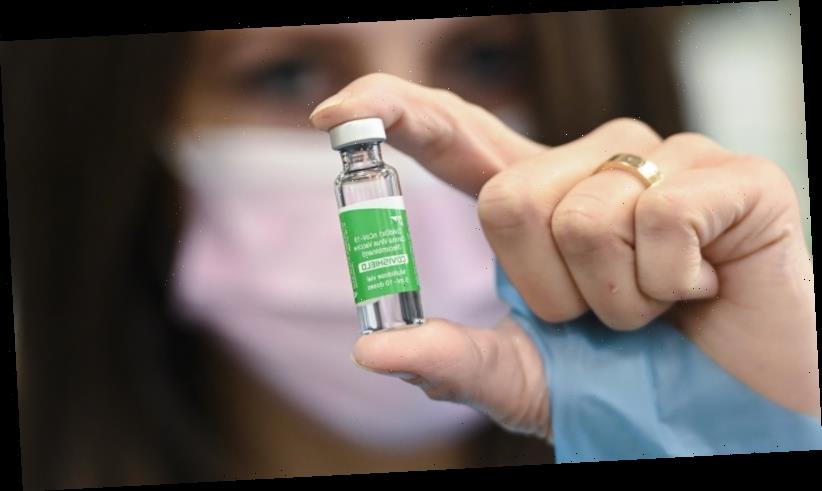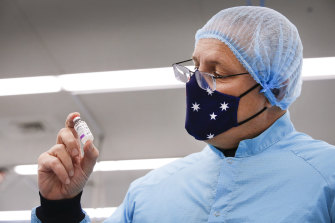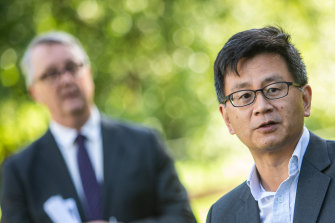
Millions eligible for the jab from Monday, but wild weather in NSW triggers some delays
03/20/2021Health authorities are scrambling to vaccinate millions of frontline workers and vulnerable people before winter starts, but the biggest vaccination campaign in Australian history will be partially delayed because of flooding in NSW.
About 6.1 million more people become eligible for the vaccine from Monday under phase 1b of the campaign. The Sunday Age and The Sun-Herald have been told the Therapeutic Goods Administration is expected to approve the locally made AstraZeneca vaccine – a critical step in unlocking millions of new doses – as soon as Monday, and these doses will ship out across the country from later this week.
Prime Minister Scott Morrison inspects a vial of the Oxford-AstraZeneca vaccine. A global scramble for vaccines is hampering Australia’s rollout. Credit: Getty
Underscoring the precarious nature of the vaccine rollout, the federal government said on Saturday that Sydney and NSW would face a delay of several days the vaccine rollout because of the heavy rains, flooding and wild weather in the state.
A federal government spokesman said overseas-sourced vaccines would be delivered to most of the country by the end of the weekend but logistics companies were having difficulties accessing some areas of NSW. More details about the delays are expected on Sunday.
Phase 1b includes healthcare workers who did not receive the jab in phase 1a, Australians aged over 70, Aboriginal and Torres Strait Islanders aged 55 and over, younger adults with a qualifying underlying medical condition or disability and disability carers, and critical and high-risk workers, including those in defence, police, fire, emergency services and meat processing.
Allen Cheng, co-chairman of the federal government’s vaccine advisory committee and Melbourne University epidemiologist Tony Blakely both flagged concerns that the colder winter months – when people spend more time inside, making it easier for airborne particles to spread the virus – posed an additional risk to the community.
Victoria’s Deputy Chief Health Officer Professor Allen Cheng addresses the media.Credit:Scott McNaughton
The arrival of the more contagious UK and South African variants in hotel quarantine and supply constraints on overseas-sourced vaccines could also heighten the risk.
Professor Cheng said, while Australia was not under the same time pressure to deliver the vaccines as countries with ongoing virus spread in the community, the government wanted to get COVID-19 vaccines to “a lot” of Australians before winter.
“That’s obviously a higher risk time,” said Professor Cheng, who is also Victoria’s Deputy Chief Health Officer.
“It is a little bit different to other countries like those in Europe and the United States where … there’s a lot of time pressure to get the vaccines out there to make sure people are protected.
“But as we all know very well, control is tenuous and just because we don’t have any cases now doesn’t mean that we won’t have one in a couple of weeks or a couple of months.
“I think it would be safe to try to get as much of the population vaccinated [as possible] by winter.”
Uncertainty over supplies – just 700,000 of a planned-for 3.8 million doses have arrived – has delayed the timeline for when Australians will receive their inoculations.
Professor Blakely said he was “90 per cent” relaxed about the pace of the vaccine rollout in Australia, even though it was slower than initially planned because of supply problems. He said local production of the AstraZeneca vaccine should scale up rapidly towards the target of 1 million doses a week.
“The part I am not relaxed about is the niggling concern with winter coming up, because as a population we have relaxed physical distancing if we have a problem in August, say, without enough people vaccinated,” he said.
“If we could magically vaccinate 60 per cent [of the population] in the next month I’d be happy, but we can’t. We are more vulnerable in winter. To sort out winter we would want at least 30 to 40 per cent of people vaccinated.”
However, University of NSW epidemiologist Professor Mary-Louise McLaws said she was not concerned about the onset of winter as Australia looked set to keep its borders largely closed for the foreseeable future, while community spread of the virus in Australia was virtually nil.
NSW reported one community case of COVID-19 last week, while Victoria reported none.
“I don’t see how winter will impact our safety. Given our borders are closed, we will be no more at risk than we are at the moment,” she said.
“We should be at less risk if all of phase 1a and quarantine staff and their household members are vaccinated, as well as every single healthcare worker.”
According to the revised timeline of vaccine dose supply released by the federal government last week, about 15 million doses – enough for about 7.5 million Australians – should have been made available by the end of May.
Prime Minister Scott Morrison has said all Australians should have had at least one dose by October.
He told The Sun-Herald and The Sunday Age that ensuring domestic vaccine manufacturing capability had been vital to Australia’s COVID-19 response.
“This week, we expect homegrown AstraZeneca vaccines to roll off the Melbourne production line and be distributed across the country,” he said.
“Making our own Australian vaccines will be a game-changer in our fight against COVID-19.”
Safety data compiled by AusVaxSafety on almost 60,000 vaccination doses given across Australia to mid-March found about 40 per cent of recipients reported some side-effects, most of which could be considered mild.
There were 0.8 per cent who had symptoms that required a visit to a doctor or emergency department.
Most of the data related to the Pfizer vaccine; 30 per cent of the 35,550 people who received the jab reported injection-site pain. About 10 per cent reported muscle or body aches and 3 per cent nausea.
The rate of adverse events in the AstraZeneca vaccine was higher at 72 per cent. However, it was based on a small sample size of 4168 people, with fatigue, headache, injection-site pain and body aches the most common symptoms.
The World Health Organisation said overnight on Friday the intense focus on a small number of blood clotting cases that caused many European countries to suspend the rollout of AstraZeneca vaccinations had undermined confidence in the jab.
No link has been established between blood clotting and the vaccine and the AstraZeneca jab has been re-endorsed by Britain, the European Medicines Agency and the WHO early on Saturday morning AEDT.
British Prime Minister Boris Johnson, who nearly died from the disease last year, received the AstraZeneca vaccine on Friday.
Sign up to our Coronavirus Update newsletter
Get our Coronavirus Update newsletter for the day’s crucial developments and the numbers you need to know. Sign up to The Sydney Morning Herald’s newsletter here and The Age’s here.
Most Viewed in Politics
From our partners
Source: Read Full Article



